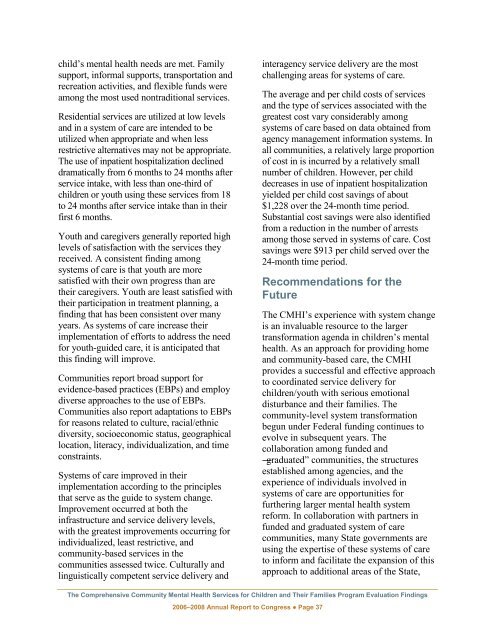Evaluation Findings - SAMHSA Store - Substance Abuse and Mental ...
Evaluation Findings - SAMHSA Store - Substance Abuse and Mental ...
Evaluation Findings - SAMHSA Store - Substance Abuse and Mental ...
You also want an ePaper? Increase the reach of your titles
YUMPU automatically turns print PDFs into web optimized ePapers that Google loves.
child’s mental health needs are met. Family<br />
support, informal supports, transportation <strong>and</strong><br />
recreation activities, <strong>and</strong> flexible funds were<br />
among the most used nontraditional services.<br />
Residential services are utilized at low levels<br />
<strong>and</strong> in a system of care are intended to be<br />
utilized when appropriate <strong>and</strong> when less<br />
restrictive alternatives may not be appropriate.<br />
The use of inpatient hospitalization declined<br />
dramatically from 6 months to 24 months after<br />
service intake, with less than one-third of<br />
children or youth using these services from 18<br />
to 24 months after service intake than in their<br />
first 6 months.<br />
Youth <strong>and</strong> caregivers generally reported high<br />
levels of satisfaction with the services they<br />
received. A consistent finding among<br />
systems of care is that youth are more<br />
satisfied with their own progress than are<br />
their caregivers. Youth are least satisfied with<br />
their participation in treatment planning, a<br />
finding that has been consistent over many<br />
years. As systems of care increase their<br />
implementation of efforts to address the need<br />
for youth-guided care, it is anticipated that<br />
this finding will improve.<br />
Communities report broad support for<br />
evidence-based practices (EBPs) <strong>and</strong> employ<br />
diverse approaches to the use of EBPs.<br />
Communities also report adaptations to EBPs<br />
for reasons related to culture, racial/ethnic<br />
diversity, socioeconomic status, geographical<br />
location, literacy, individualization, <strong>and</strong> time<br />
constraints.<br />
Systems of care improved in their<br />
implementation according to the principles<br />
that serve as the guide to system change.<br />
Improvement occurred at both the<br />
infrastructure <strong>and</strong> service delivery levels,<br />
with the greatest improvements occurring for<br />
individualized, least restrictive, <strong>and</strong><br />
community-based services in the<br />
communities assessed twice. Culturally <strong>and</strong><br />
linguistically competent service delivery <strong>and</strong><br />
interagency service delivery are the most<br />
challenging areas for systems of care.<br />
The average <strong>and</strong> per child costs of services<br />
<strong>and</strong> the type of services associated with the<br />
greatest cost vary considerably among<br />
systems of care based on data obtained from<br />
agency management information systems. In<br />
all communities, a relatively large proportion<br />
of cost in is incurred by a relatively small<br />
number of children. However, per child<br />
decreases in use of inpatient hospitalization<br />
yielded per child cost savings of about<br />
$1,228 over the 24-month time period.<br />
Substantial cost savings were also identified<br />
from a reduction in the number of arrests<br />
among those served in systems of care. Cost<br />
savings were $913 per child served over the<br />
24-month time period.<br />
Recommendations for the<br />
Future<br />
The CMHI’s experience with system change<br />
is an invaluable resource to the larger<br />
transformation agenda in children’s mental<br />
health. As an approach for providing home<br />
<strong>and</strong> community-based care, the CMHI<br />
provides a successful <strong>and</strong> effective approach<br />
to coordinated service delivery for<br />
children/youth with serious emotional<br />
disturbance <strong>and</strong> their families. The<br />
community-level system transformation<br />
begun under Federal funding continues to<br />
evolve in subsequent years. The<br />
collaboration among funded <strong>and</strong><br />
―graduated‖ communities, the structures<br />
established among agencies, <strong>and</strong> the<br />
experience of individuals involved in<br />
systems of care are opportunities for<br />
furthering larger mental health system<br />
reform. In collaboration with partners in<br />
funded <strong>and</strong> graduated system of care<br />
communities, many State governments are<br />
using the expertise of these systems of care<br />
to inform <strong>and</strong> facilitate the expansion of this<br />
approach to additional areas of the State,<br />
The Comprehensive Community <strong>Mental</strong> Health Services for Children <strong>and</strong> Their Families Program <strong>Evaluation</strong> <strong>Findings</strong><br />
2006–2008 Annual Report to Congress ● Page 37

















